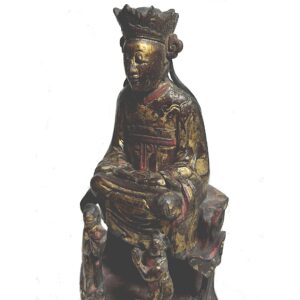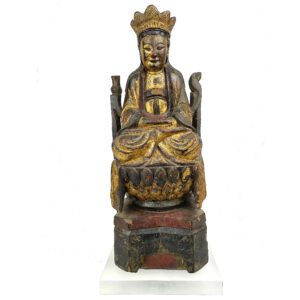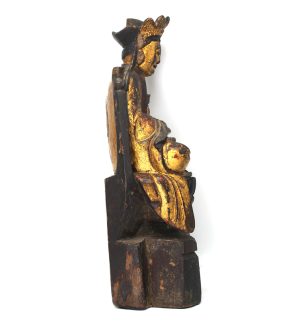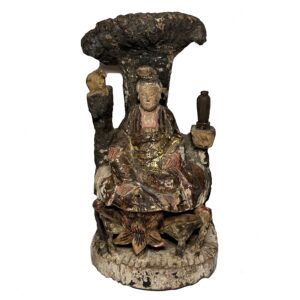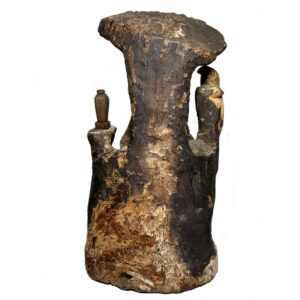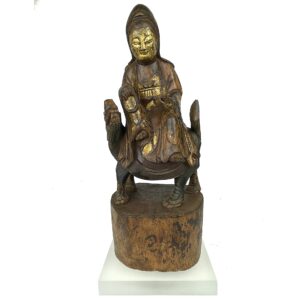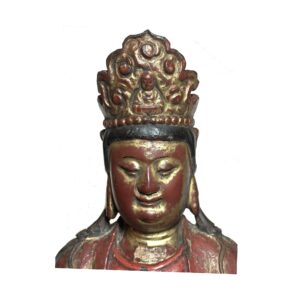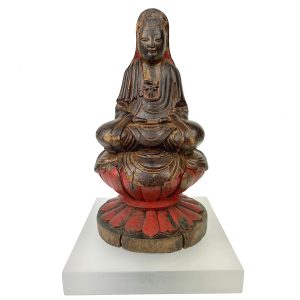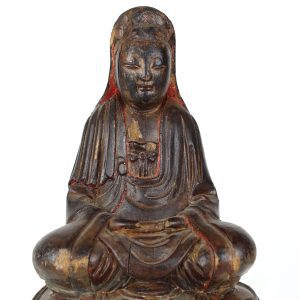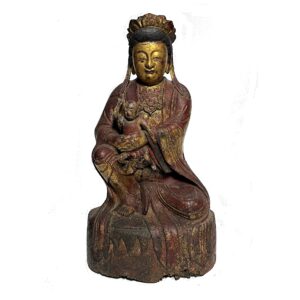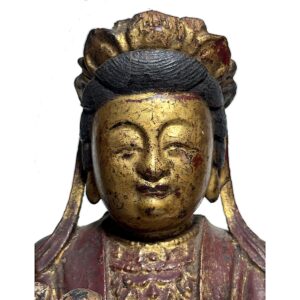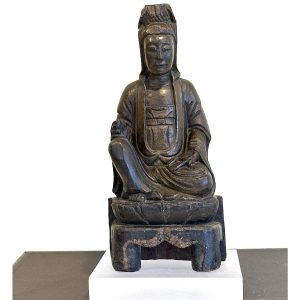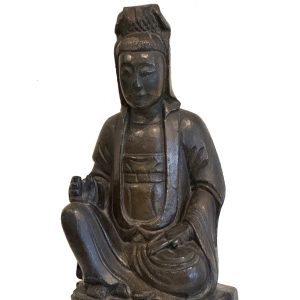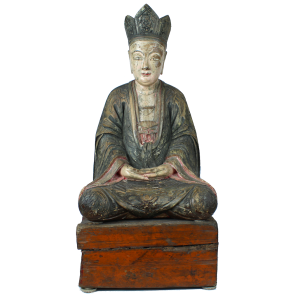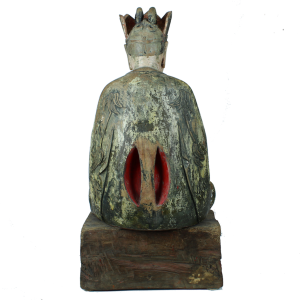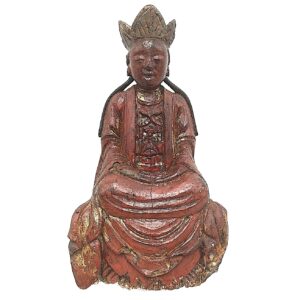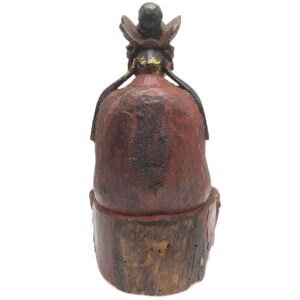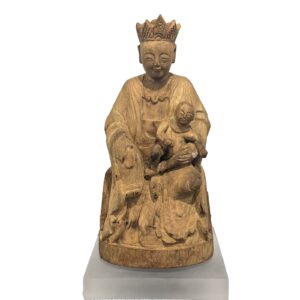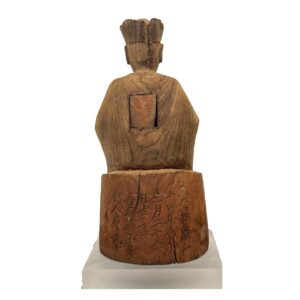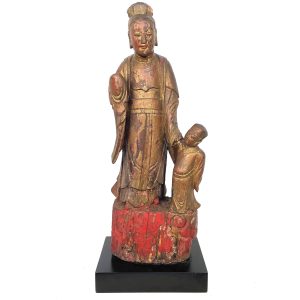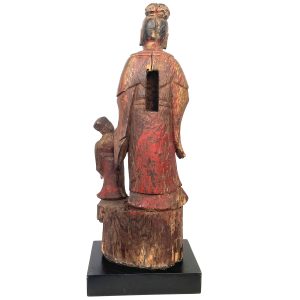Showing 13–24 of 38 results
-
Sale!


$1,350.00 Original price was: $1,350.00.$1,200.00Current price is: $1,200.00.
H: 11.5″ W: 6″ D: 4.5″ | FREE SHIPPING IN CONTINENTAL U.S.
Nanhai Guanyin on Mount Putuo sits as a triad with acolytes Shan Tsai hands in prayer and the Dragon Princess offering the “illuminating pearl.” Very rare Ming sculpture on an Acrylic base is one of our favorites VA collection carvings.
-
Sale!


$1,450.00 Original price was: $1,450.00.$1,150.00Current price is: $1,150.00.
H: 15.5″ W: 6″ D: 5.25″ | CALL 213-568-3030 OR EMAIL VANISHINGARTS213@GMAIL/COM for shipping information
Elegant Guanyin in meditation, gilt covered with five-lobed crown. Sacred vial on her right and parrot on left. Guanyins statues with symbols in this condition are rare and impart a feeling of serenity to the environment around them.
-
Sale!


$595.00 Original price was: $595.00.$525.00Current price is: $525.00.
H: 9.75″ W: 5″ D: 4.5″ | FREE SHIPPING within continental u.s.
Nanhai Guanyin in her Cave in lalitsana, below draped moss arch holding a scrolls, next to vial of humanity’s tears and parrot, her constant companion. Small Nanhai images with these symbols are very rare.
-
Sale!


$725.00 Original price was: $725.00.$585.00Current price is: $585.00.
H: 15.125” W: 6” D: 5” | FREE SHIPPING within Continental U.S.
Rare provincial carving of Guanyin in lalitsana clasping a rosary on a mythical Hǒu that symbolizes righteousness, morality and ushers in peace and prosperity. Small yet powerful, consecrated and mounted on Acrylic base.
-
Sale!


$3,750.00 Original price was: $3,750.00.$2,900.00Current price is: $2,900.00.
H: 19″ W: 10″ D: 8″ | CALL 213-568-3030 OR EMAIL [email protected] for shipping INFORMATION.
Wonderfully carved Nanhai Guanyin with ornate and beautiful diadem centered by elaborately framed Buddha Amitabha in meditation. Vibrant aura radiates spirituality, opulence, serenity and strength, as well as compassion and grace, making this a truly masterful piece of art.
-
Sale!


$495.00 Original price was: $495.00.$395.00Current price is: $395.00.
H: 8.675″ Dia: 4.5″ | Free SHIPPING WITHIN CONTINENTAL U.S.
Delicate white robed Guanyin in meditation on radiating lotus throne. Provincial humble, modest, relatable, yet beautiful matronly figure.
-
Sale!


$2,650.00 Original price was: $2,650.00.$1,975.00Current price is: $1,975.00.
H: 14.5” W: 8.25” D: 5” | CALL 213-568-3030 OR EMAIL [email protected] FOR SHIPPING.
Rare and beautiful provincial Songzi Guanyin is modest, compassionate and humble with lotus leaf crown, unadorned robe and pedestal with simple leaves. Her baby resembles the infant Buddha. Was probably on a home altar of wealthy couple desiring a (male) baby.
-
Sale!


$785.00 Original price was: $785.00.$625.00Current price is: $625.00.
H: 10.75″ W: 5.5″ D: 4.5″ | FREE SHIPPING IN CONTINENTAL U.S.
White clad Guanyin in royal ease and karana mudra to expel evil, remove problems and rid sickness or other negativities rarely used for Guanyin. Consecrated for home altar use.
-
Sale!


$4,450.00 Original price was: $4,450.00.$3,500.00Current price is: $3,500.00.
Ht: 27.5” W:13.5: D: 10.25” | CALL 213-568-3030 FOR SHIPPING QUOTE OR EMAIL US AT [email protected]
Magnificent example of fine provincial Buddhist statues. Made to be seen in the round, her garment has delicate incised leaves and leaf motifs on front, back, and sleeves. High pointed crown with the Five Tantric Dhyani Buddhas, rare in provincial Guanyins.
-
Sale!


$425.00 Original price was: $425.00.$295.00Current price is: $295.00.
H:9.75″ W: 5.6″ D: 3.75″ | FREE SHIPPING WITHIN CONTINENTAL U.S.
Consecrated red lacquer and gilt home altar provincial Guanyin, elaborate 5-lobed crown centered with radiating bars symbolizing Amitabha Buddha and his aureole that represent the flames of Buddhism.
-
Sale!


$1,350.00 Original price was: $1,350.00.$1,100.00Current price is: $1,100.00.
H: 11” W: 5.75” D: 5.125” | FREE SHIPPING WITHIN CONTINENTAL U.S.
Very rare and fine 16th century home shrine image with compassionate countenance of Songzi Guanyin the “Bestower of Children.” With joyful half-closed eyes, she looks lovingly at the child whose arm is draped over hers.and leans slightly forward.Wearing a 5- lobed crown centered with a camellia flower a Chinese symbol of young sons and daughters. Inscription dates it to 1521-1567
-
Sale!


$2,250.00 Original price was: $2,250.00.$1,700.00Current price is: $1,700.00.
Ht: 26” W: 10.25” D: 7.5″ |CALL 213-568-3030 OR EMAIL [email protected] FOR SHIPPING
Rare provincial image of Guanyin tenderly holding a young child’s hand similar to Songzi “Child-Giving Guanyin”. Consecrated with vibrant gilt and red surface in front and back.
End of content
End of content


